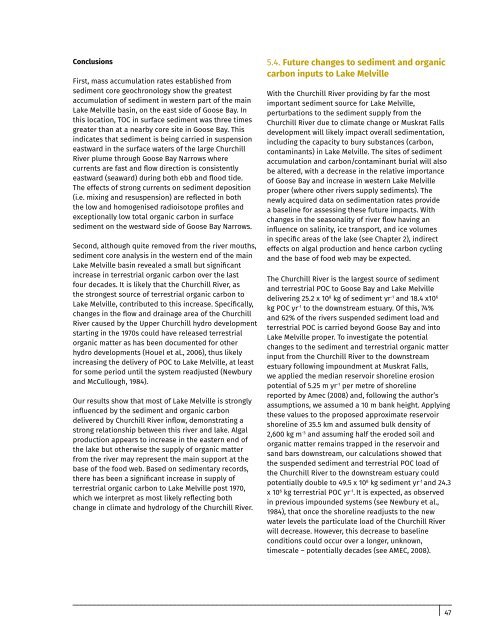Lake Melville
1rw7Mns
1rw7Mns
You also want an ePaper? Increase the reach of your titles
YUMPU automatically turns print PDFs into web optimized ePapers that Google loves.
Conclusions<br />
First, mass accumulation rates established from<br />
sediment core geochronology show the greatest<br />
accumulation of sediment in western part of the main<br />
<strong>Lake</strong> <strong>Melville</strong> basin, on the east side of Goose Bay. In<br />
this location, TOC in surface sediment was three times<br />
greater than at a nearby core site in Goose Bay. This<br />
indicates that sediment is being carried in suspension<br />
eastward in the surface waters of the large Churchill<br />
River plume through Goose Bay Narrows where<br />
currents are fast and flow direction is consistently<br />
eastward (seaward) during both ebb and flood tide.<br />
The effects of strong currents on sediment deposition<br />
(i.e. mixing and resuspension) are reflected in both<br />
the low and homogenised radioisotope profiles and<br />
exceptionally low total organic carbon in surface<br />
sediment on the westward side of Goose Bay Narrows.<br />
Second, although quite removed from the river mouths,<br />
sediment core analysis in the western end of the main<br />
<strong>Lake</strong> <strong>Melville</strong> basin revealed a small but significant<br />
increase in terrestrial organic carbon over the last<br />
four decades. It is likely that the Churchill River, as<br />
the strongest source of terrestrial organic carbon to<br />
<strong>Lake</strong> <strong>Melville</strong>, contributed to this increase. Specifically,<br />
changes in the flow and drainage area of the Churchill<br />
River caused by the Upper Churchill hydro development<br />
starting in the 1970s could have released terrestrial<br />
organic matter as has been documented for other<br />
hydro developments (Houel et al., 2006), thus likely<br />
increasing the delivery of POC to <strong>Lake</strong> <strong>Melville</strong>, at least<br />
for some period until the system readjusted (Newbury<br />
and McCullough, 1984).<br />
Our results show that most of <strong>Lake</strong> <strong>Melville</strong> is strongly<br />
influenced by the sediment and organic carbon<br />
delivered by Churchill River inflow, demonstrating a<br />
strong relationship between this river and lake. Algal<br />
production appears to increase in the eastern end of<br />
the lake but otherwise the supply of organic matter<br />
from the river may represent the main support at the<br />
base of the food web. Based on sedimentary records,<br />
there has been a significant increase in supply of<br />
terrestrial organic carbon to <strong>Lake</strong> <strong>Melville</strong> post 1970,<br />
which we interpret as most likely reflecting both<br />
change in climate and hydrology of the Churchill River.<br />
5.4. Future changes to sediment and organic<br />
carbon inputs to <strong>Lake</strong> <strong>Melville</strong><br />
With the Churchill River providing by far the most<br />
important sediment source for <strong>Lake</strong> <strong>Melville</strong>,<br />
perturbations to the sediment supply from the<br />
Churchill River due to climate change or Muskrat Falls<br />
development will likely impact overall sedimentation,<br />
including the capacity to bury substances (carbon,<br />
contaminants) in <strong>Lake</strong> <strong>Melville</strong>. The sites of sediment<br />
accumulation and carbon/contaminant burial will also<br />
be altered, with a decrease in the relative importance<br />
of Goose Bay and increase in western <strong>Lake</strong> <strong>Melville</strong><br />
proper (where other rivers supply sediments). The<br />
newly acquired data on sedimentation rates provide<br />
a baseline for assessing these future impacts. With<br />
changes in the seasonality of river flow having an<br />
influence on salinity, ice transport, and ice volumes<br />
in specific areas of the lake (see Chapter 2), indirect<br />
effects on algal production and hence carbon cycling<br />
and the base of food web may be expected.<br />
The Churchill River is the largest source of sediment<br />
and terrestrial POC to Goose Bay and <strong>Lake</strong> <strong>Melville</strong><br />
delivering 25.2 x 10 8 kg of sediment yr -1 and 18.4 x10 6<br />
kg POC yr -1 to the downstream estuary. Of this, 74%<br />
and 62% of the rivers suspended sediment load and<br />
terrestrial POC is carried beyond Goose Bay and into<br />
<strong>Lake</strong> <strong>Melville</strong> proper. To investigate the potential<br />
changes to the sediment and terrestrial organic matter<br />
input from the Churchill River to the downstream<br />
estuary following impoundment at Muskrat Falls,<br />
we applied the median reservoir shoreline erosion<br />
potential of 5.25 m yr -1 per metre of shoreline<br />
reported by Amec (2008) and, following the author’s<br />
assumptions, we assumed a 10 m bank height. Applying<br />
these values to the proposed approximate reservoir<br />
shoreline of 35.5 km and assumed bulk density of<br />
2,600 kg m -3 and assuming half the eroded soil and<br />
organic matter remains trapped in the reservoir and<br />
sand bars downstream, our calculations showed that<br />
the suspended sediment and terrestrial POC load of<br />
the Churchill River to the downstream estuary could<br />
potentially double to 49.5 x 10 8 kg sediment yr -1 and 24.3<br />
x 10 6 kg terrestrial POC yr -1 . It is expected, as observed<br />
in previous impounded systems (see Newbury et al.,<br />
1984), that once the shoreline readjusts to the new<br />
water levels the particulate load of the Churchill River<br />
will decrease. However, this decrease to baseline<br />
conditions could occur over a longer, unknown,<br />
timescale – potentially decades (see AMEC, 2008).<br />
47


